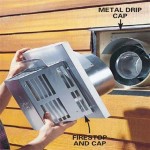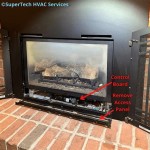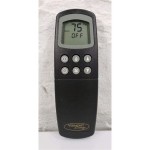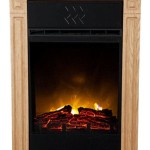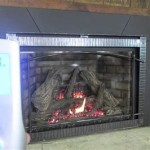Gas Fireplace Insert Replacement: A Comprehensive Guide
Gas fireplace inserts offer a convenient and efficient way to enhance the warmth and ambiance of a home. Over time, however, these inserts can become outdated, inefficient, or even malfunction, necessitating replacement. Understanding the factors involved in gas fireplace insert replacement, from assessing the need to choosing the right model and ensuring proper installation, is crucial for homeowners considering this upgrade.
This article provides a comprehensive overview of gas fireplace insert replacement, covering the key considerations, steps involved, and potential challenges. It aims to equip homeowners with the knowledge necessary to make informed decisions and navigate the replacement process effectively.
Assessing the Need for Replacement
The decision to replace a gas fireplace insert should be based on a thorough assessment of its current condition and performance. Several factors can indicate the need for replacement. One primary indicator is decreased heating efficiency. If the fireplace is no longer producing the same level of heat as before, despite consistent usage, it could signify internal component degradation, such as a failing burner or gas valve. Inefficient operation translates to higher energy bills and diminished comfort.
Visible signs of damage, such as cracks in the firebox, corroded components, or a malfunctioning pilot light, also point to the need for replacement. These issues not only affect the fireplace's performance but also pose potential safety hazards. Gas leaks, for example, can result from corroded gas lines or faulty connections, requiring immediate attention and potentially replacement of the entire unit.
Technological obsolescence is another factor to consider. Older gas fireplace inserts may lack modern features like remote control operation, programmable thermostats, or advanced safety mechanisms. Upgrading to a newer model can provide enhanced convenience, improved energy efficiency, and increased safety features. Furthermore, aesthetic considerations might drive the replacement decision. A dated or visually unappealing insert can detract from the overall look of a room. Replacing it with a more modern and stylish model can significantly improve the room's aesthetic appeal.
Ultimately, a comprehensive assessment involving both visual inspection and performance evaluation is essential to determine whether replacement is the most appropriate course of action. Consulting with a qualified fireplace technician can provide valuable insights and professional recommendations.
Selecting the Right Replacement Insert
Choosing the correct replacement gas fireplace insert involves considering several crucial factors to ensure optimal performance, safety, and aesthetic compatibility. The primary factor is sizing. The firebox opening must be accurately measured to ensure the new insert fits properly. An insert that is too large will not fit, while an insert that is too small may not provide adequate heating and could compromise the fireplace's overall appearance. Manufacturers provide specific sizing guidelines, and consulting with a professional installer is highly recommended to ensure proper fit.
Heating capacity, measured in British Thermal Units (BTUs), is another key consideration. The BTU rating should be appropriate for the size of the room or area the fireplace is intended to heat. A higher BTU rating is necessary for larger spaces, while a lower BTU rating is sufficient for smaller rooms. Over-sizing the insert can lead to overheating and discomfort, while under-sizing it can result in insufficient heat output. Factors such as insulation levels, window area, and ceiling height should also be taken into account when determining the appropriate BTU rating.
Efficiency ratings are crucial for minimizing energy consumption and reducing heating costs. Gas fireplace inserts are rated for their Annual Fuel Utilization Efficiency (AFUE). A higher AFUE rating indicates a more efficient unit, meaning it converts a greater percentage of the fuel into usable heat. Look for inserts with high AFUE ratings to maximize energy savings. Also, consider features like intermittent pilot ignition (IPI) or electronic ignition, which eliminate the standing pilot light and further reduce energy waste.
Aesthetic preferences play a significant role in the selection process. Gas fireplace inserts are available in a wide range of styles, finishes, and designs. Choose an insert that complements the existing décor and architectural style of the room. Consider factors such as the type of logs, the flame pattern, and the overall appearance of the unit. Options include traditional log sets, contemporary glass media, and various decorative fronts and surrounds. Selecting an insert that aligns with personal taste and enhances the room's aesthetic appeal is essential for long-term satisfaction.
Finally, budget constraints should be considered. Gas fireplace inserts vary significantly in price, depending on features, efficiency, and brand. Establish a budget beforehand and research different models within that price range. Consider the long-term cost savings associated with a more efficient unit, as well as any potential rebates or incentives that may be available. Balancing cost with desired features and performance is crucial for making a sound investment.
The Replacement Process: Step-by-Step
The replacement of a gas fireplace insert involves a series of carefully executed steps to ensure safety and proper functionality. The initial step is disconnecting the existing gas line. This should be performed by a qualified professional to prevent gas leaks or other hazards. The gas supply should be shut off at the main valve, and any remaining gas in the line should be purged. The existing gas line should be capped off securely before proceeding with the removal of the old insert.
Next, the existing fireplace insert must be carefully removed from the firebox. This typically involves disconnecting any electrical connections and removing any screws or fasteners securing the insert in place. Depending on the size and weight of the insert, assistance may be required to lift and remove it safely. Take precautions to protect the surrounding area from damage during removal.
Before installing the new insert, the firebox should be thoroughly cleaned and inspected. Remove any debris, soot, or creosote buildup. Check the chimney flue for any obstructions or damage. If necessary, have the chimney professionally cleaned and inspected to ensure it is in good working order. A clean and properly functioning chimney is essential for safe and efficient operation of the gas fireplace insert.
The new gas fireplace insert can then be installed. Carefully follow the manufacturer's instructions for installation. Ensure the insert is properly positioned and secured within the firebox. Connect the gas line using appropriate fittings and sealant. A qualified professional should perform the gas line connection to ensure it is leak-free and meets all safety codes.
After connecting the gas line, perform a leak test using a gas leak detector or soapy water solution. Apply the solution to all gas connections and check for bubbles, which indicate a leak. If a leak is detected, immediately shut off the gas supply and tighten the connections. Repeat the leak test until no leaks are present. Once the gas line is confirmed to be leak-free, connect any electrical connections and install any decorative trim or surrounds.
Finally, test the new gas fireplace insert to ensure it is functioning properly. Start the pilot light and check the flame pattern. Verify that the blower motor (if applicable) is operating smoothly. Adjust the gas valve and air shutter to achieve optimal flame appearance and heat output. Monitor the fireplace for any unusual noises or smells. If any issues are detected, consult with a qualified technician for troubleshooting and repair.
Potential Challenges and Considerations
Replacing a gas fireplace insert can present several potential challenges and considerations that homeowners should be aware of. One common challenge is dealing with older gas lines. In some cases, the existing gas line may be outdated or incompatible with the new insert. It may be necessary to upgrade the gas line to meet current safety codes and ensure adequate gas supply. This can involve additional costs and require the services of a licensed gas fitter.
Chimney issues can also pose a significant challenge. If the chimney is damaged, blocked, or improperly sized, it can affect the performance and safety of the gas fireplace insert. A professional chimney inspection is crucial to identify any potential problems and ensure the chimney is suitable for the new insert. In some cases, it may be necessary to repair or reline the chimney, which can add to the overall cost of the replacement project.
Permits and inspections are often required for gas fireplace insert replacements. Local building codes may require a permit for any gas-related work, including the installation of a new fireplace insert. Obtain the necessary permits before starting the project to avoid potential fines or delays. Once the installation is complete, a building inspector may need to inspect the work to ensure it complies with all applicable codes.
Compatibility issues between the new insert and the existing firebox can also arise. While most inserts are designed to fit standard firebox openings, there may be slight variations in size or shape that require adjustments. In some cases, it may be necessary to modify the firebox to accommodate the new insert. This can involve cutting, filling, or reinforcing the firebox walls. Consulting with a professional installer can help identify and address any compatibility issues before installation.
Finally, proper ventilation is crucial for the safe and efficient operation of a gas fireplace insert. Ensure the chimney flue is properly sized and unobstructed. Avoid blocking any air vents or louvers on the insert, as this can restrict airflow and lead to overheating. Regular maintenance, such as cleaning the burner and venting system, is also essential for maintaining optimal performance and preventing potential safety hazards. Following the manufacturer's recommendations for maintenance and care will help prolong the life of the gas fireplace insert and ensure its continued safe operation.

Convert To Gas Installing Fireplace Inserts Doctor Flue
How To Install Gas Fireplace Insert Heat Glo

Gas Fireplace Inserts Fireplacesdirect Com

Gas Fireplace Insert Propane Regency Vermont Castings Napoleon

Fireplaces Inserts Wood Gas Fireplace Xtrordinair

How To Modernize And Update A Gas Fireplace We Love Fire

Fireplaceinserts Net Osburn 1100 Fireplace Insert

A Step By Guide To Understanding Fireplace Inserts

Replacing Your Condo Fireplace Vancouver Gas Fireplaces

Existing Fireplace Or A Brand New Build Lopi Fireplaces
Related Posts

